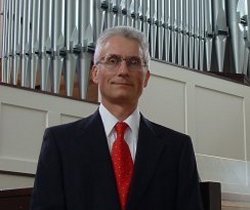
| | Organist | Accordionist | Composer | Conductor | Author | Educator |

 |
Henry Doktorski
|
 |
Aril 2005: Henry Doktorski appeared with the Pittsburgh Symphony Orchestra in three performances of Arturs Maskats' Tango on April 8-10 at Heinz Hall in Pittsburgh, Pennsylvania.The twelve-minute work, directed by the Russian-born guest conductor Yakov Kreizberg, is scored for piccolo, two flutes, two oboes, three clarinets, bass clarinet, three bassoons, contrabassoon, four horns, three trumpets, three trombones, tuba, timpani, two harps, harpsichord, celeste, wood drum, three bongos, triangle, snare drum, jazz drum, guiro, bass drum, caracas, sleigh bells, crotales, cymbals, two woodblocks, xylophone, glockenspiel, claves, bandone n and strings.
Maestro Yakov Kreizberg, born in Saint Petersburg, currently holds the posts of chief conductor and artistic advisor for the Netherlands Philharmonic and the Netherlands Chamber Orchestras. He also serves as the principal guest conductor for the Vienna Symphony Orchestra.
Composer Arturs Maskats was born in Valmiera, Latvia, in 1957, and currently serves as a Professor of Composition at the Jazeps Vitols Academy of Music in Riga. His Tango, composed in 2002, was selected as one of the six finalists (out of more than 1,000 entries) at the prestigious British "Masterprize" competition in 2003.
Maskats wrote, "Tango -- in taverns, in city streets flashing with midnight lights, and tango -- in the greatest theatres, the most illustrious concert houses. Tangos have been written by Stravinsky, Ravel, Shostakovich, even our own Janis Medins, and by many, many others. Astor Piazzolla -- the classic writer of tangos, one of the late 20th century's most distinctive musical voices. I wanted to unite all these many facets of tango in one dramatic story for symphony orchestra. Ravel did something on these lines at the beginning of the 20th century with the waltz. I would like to try it out with the tango!"
Doktorski said, "The bandone n part appears three times in the score. First it enters during the subito dolce section where it plays a solo melody, graceful yet syncopated. It appears again playing a sustained and dissonant chord marked "fff" at the end of the allegretto section leading into the Andante tranquillo. Finally, the instrument plays an eleven-measure solo cadenza just a few bars before the conclusion of the piece, while the entire orchestra tacets. The cadenza, marked dolce, has an essentially four-voice contrapuntal texture with several interesting melodic lines within the voices, playable only on a free-bass accordion. I used the right-hand oboe stop (one middle and one high reed) as I thought that more accurately imitated the sound of a bandone n on my particular instrument. I also played the cadenza with varying degrees of rubato. The conductor did not conduct me during the cadenza, but lowered his baton and let me play it as I saw fit."
Doktorski concluded, "Maestro Kreizberg was a diligent director, as during rehearsals he several times asked me to play various excerpts from my part and sometimes suggested various interpretations. Although thorough, I thought he was also a sensitive and kind conductor. As I prepared to walk out on stage during the third and final performance, he met me backstage, put his arm around my shoulder, casually mentioned that the composer happened to be in the audience that afternoon, and very politely (and with a huge smile) requested that I play the cadenza a little faster and more "straight," i.e., with less rubato. Of course, during the performance I did my best to follow his direction, and I thought that Sunday afternoon's performance was the best of all three. After the concert, Kriezberg met me again backstage and smiled, "You have made the composer very happy."
I replied, "Thanks. I am very happy to have contributed some small part towards the success of this concert."
|